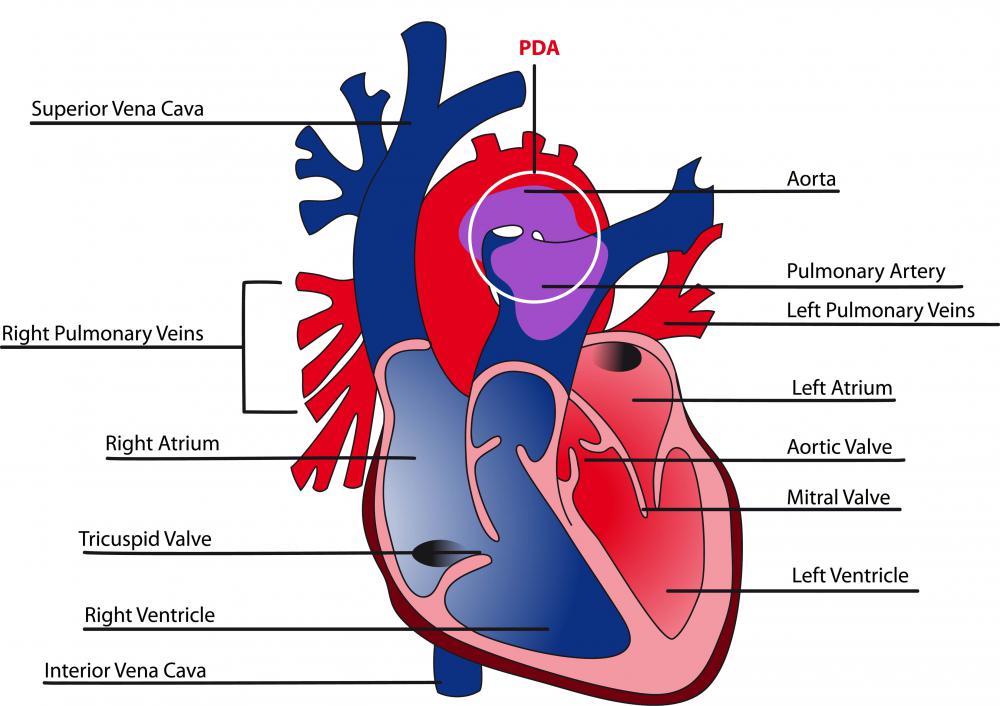At WiseGEEK, we're committed to delivering accurate, trustworthy information. Our expert-authored content is rigorously fact-checked and sourced from credible authorities. Discover how we uphold the highest standards in providing you with reliable knowledge.
What is Left-Sided Heart Failure?
Left-sided heart failure is a very serious condition in which the ability of the left side of the heart to pump blood out to the rest of the body is compromised. The heart can no longer keep up with the body’s need for oxygen-rich blood, leading to symptoms of fatigue and labored breathing. Other symptoms of left-sided heart failure include a productive cough, sometimes with slightly bloody mucus, nausea, abdominal swelling, heart palpitations, irregular heartbeat, weakness, inability to concentrate, swelling in the feet and ankles, and loss of appetite. If these symptoms appear suddenly or worsen suddenly, it may be a sign of acute heart failure.
In a healthy heart, the left side of the heart receives freshly oxygenated blood from the lungs and pumps it out to the rest of the body. When the left side of the heart is damaged, it often leads the person to feel tired, weak, and short of breath. Left-sided heart failure is the most common type of heart failure, over right-sided and bi-ventricular heart failure, and often the first type to occur in a gradually worsening heart. The failure may be systolic, in which the left ventricle has trouble pumping, or diastolic, in which the left ventricle cannot fill properly.

The causes of left-sided heart failure vary from patient to patient. In adults, the most common cause is coronary artery disease (CAD), a disease in which the walls of the arteries that feed blood to the heart harden due to the accumulation of fatty deposits. Sometimes these deposits rupture and block blood flow to the tissue of the heart, causing a heart attack. CAD by itself or with a heart attack can cause the damage that leads to left-sided heart failure. High blood pressure, diabetes, alcoholism, drug use, bacterial or viral infections of the heart, and arrhythmias, or irregular heartbeat, can also contribute to heart failure. In children, left-sided heart failure is usually due to birth defects, such as faulty valves or undeveloped chambers of the heart.

The risks of left-sided heart failure increase with age. Other risk factors include many of the conditions earlier listed as causes, such as drug use, diabetes, coronary artery disease, alcoholism, heart attack, kidney problems, arrhythmia, sleep apnea, heart defects, and certain viral infections. In turn, left-sided heart failure increases risks of liver problems, heart attack, heart valve damage, stroke, and kidney damage.

Treatments for left-sided heart failure depend on the cause of the heart problem. Patients are often asked to make lifestyle changes such as eating less salt, lowering cholesterol, and exercising. Medications may also be used to treat the causes and symptoms of heart failure. Angiotensin-converting enzyme (ACE) inhibitors help reduce the strain on the heart by dilating blood vessels, digitalis supports heart contractions, diuretics help manage swelling by getting rid of excess fluids through urination, beta blockers manage arrhythmia, and aldosterone antagonists are medications that, if carefully managed, can act as diuretics and proponents of heart healing. Some people may need surgery to repair their heart damage and others may require a heart transplant. Left-side heart failure is a serious condition that can be fatal and requires lifetime management to ensure the longest, highest quality life.
AS FEATURED ON:
AS FEATURED ON:















Discuss this Article
Post your comments